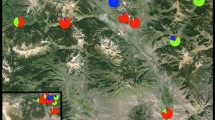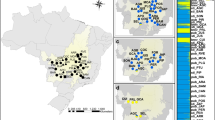Abstract
The terrestrial orchid speciesNeotinea ustulata has recently been split into two subspecies, differing remarkably in their flowering time, but only slightly in morphological characteristics, which makes their taxonomic status uncertain. We have analyzed morphometric and genetic differences between the early- and late-flowering populations in Central Europe. Our results on morphology are ambiguous. Indirect gradient analysis has not shown a distinct separation of early- and late-flowering individuals in the ordination space. However, according to MANOVA, populations of early- and late-flowering plants can be distinguished by plant height, leaf length, numbers of basal (rosette) and stem leaves and even better by certain ratios of these numbers. All genetic analyses, on the other hand, are definite and consistently distinguish two groups. Random amplified polymorphic DNA (RAPD) markers have shown that the early- and late-flowering populations differ significantly from one another. Principal coordinate analysis (PCoA) based on presence/absence matrix of RAPD bands separated the two groups, implying that the difference in flowering phenology could form an effective barrier to gene exchange. Partitioning of genetic diversity in analysis of molecular variance (AMOVA) has shown that the genetic divergence between the two groups, early- and late-flowering populations, is somewhat greater (33%) than the genetic variability among populations within particular group (23%). Using the Mantel test, we found that genetic differentiation coefficients between populations closely correspond to their geographic distribution. After elimination of the effect of sample origin from the model, direct gradient analysis (RDA) has shown that the early- and late-flowering groups differ significantly in their RAPD spectra. To conclude, our results indicate the presence of two genetically and phenologically distinct taxa, but the weak morphological differentiation supports the taxonomic rank of variety rather than subspecies.
Similar content being viewed by others
References
Bateman R.M., Pridgeon A.M. &Chase M.W. (1997): Phylogenetic of subtribeOrchidinae (Orchidoideae, Orchidaceae) based on nuclear ITS sequences. 2. Infrageneric relationships and reclassification to achieve monophyly ofOrchis sensu stricto.Lindleyana 12: 113–141.
Bateman R.M. (2001): Evolution and classification of European orchids: insights from molecular and morphological characters.J. Eur. Orchideen 33: 33–119.
Bateman R.M., Hollingsworth P.M., Preston J., Yi-Bo L., Pridgeon A.M. &Chase M.W. (2003): Molecular phylogenetics and evolution ofOrchidinae and selectedHabenariinae (Orchidaceae).Bot. J. Linn. Soc. 142: 1–40.
Borg S.J. (1972):Variability of Rhinanthus serotinus (Schönh.)Oborny in relation to environment. Thesis, Rijksuniversiteit te Groeningen, Groeningen.
Caporali E., Grünanger P., Marziani G., Servettaz O. &Spada A. (2001): Molecular (RAPD) analysis of some taxa of theOphrys bertolonii aggregate.Israel J. Pl. Sci. 49: 85–89.
Davies P., Davies J. &Huxley A. (1988):Wild orchids of Britain and Europe. Chatto & Windus, The Hogarth Press, London.
Dubouzet J.G., Murata N. &Shinoda K. (1997): RAPD analysis of genetic relationship amongAlstromeria L. cultuvars.Sci. Hort. 68: 181–189.
Farrel L. (1985): Biological Flora of the British Isles, No. 160.Orchis militaris L.J. Ecol. 73: 1041–53.
Foley M.J.Y. (1987): The current distribution and abundance ofOrchis ustulata L. in northern England.Watsonia 16: 409–415.
Foley M.J.Y. (1990): The current distribution and abundance ofOrchis ustulata L. in southern England.Watsonia 18: 37–42.
Foley M.J.Y. (1992): The current distribution and abundance ofOrchis ustulata L. (Orchidaceae) in the British Isles — an updated summary.Watsonia 19: 121–126.
Gumprecht R. (1981): SpätblühendeOrchis ustulata.Orchidee 31: 36.
Huff D.R., Peakall R. &Smouse P.E. (1993): RAPD variation within and among natural populations of outcrossing buffalograss [Buchloë decatyloides (Nutt.)Engelm.].Theor. Appl. Genet. 86: 927–934.
Jacquet P. &Scappaticci G. (2003):Troisième mise à jour. Une Répartition des Orchidées sauvages de France. Société Française d’Orchidophile, Paris.
Jenkinson M.N. (1995):Wild orchids of Hampshire and the isle of Wight. Orchid Sundries Ltd., Gillingham.
Jensen J.M. &Pedersen H.A. (1999): Ny lokalitet for Bakke-Gogeurt (Orchis ustulata) — med noter om artens fanologiske og morfologiske variation (A new station forOrchis ustulata — with notes on the phenological and morphological variation of this species).Flora og Fauna 105: 29–36.
Kreutz C.A.J. &Dekker H. (2000):De orchideeën van Nederland — ecologie, verspreiding, bedreiging, beheer (Orchids of the Netherlands — ecology, distribution, threat, conservation). Uitgave Kreutz & Seckel, Landgraaf & Raalte.
Kümpel H. (1988): Über eine spätblühendeOrchis ustulata-Sippe.Haussknechita 4: 23–24.
Kümpel H. &Mrkvicka A.Ch. (1990): Untersuchungen zur Abtrennung derOrchis ustulata L. subsp.aestivalis (Kümpel)Kümpel & Mrkvicka.Mitt. Arebeitskreis Heimische Orchid.Baden-Württemberg 22: 306–324.
Lennartsson T. (1997): Seasonal differentiation — a conservative reproductive barrier in two grasslandGentianella (Gentianaceae) species.Pl. Syst. Evol. 208: 45–69.
Levi A., Rowland L.J. &Hartung J.S. (1993): Production of reliable randomly amplified polymorphic DNA (RAPD) markers from DNA of woody plants.Hort. Sci. 28: 1188–1190.
Lihová J., Marhold K. &Neuffer B. (2000): Taxonomy ofCardamine amara (Cruciferae) in the Iberian Peninsula.Taxon 49: 747–763.
Lim S.H., Liew C.F., Lim C.N., Lee Y.H. &Goh C.J. (1997): A simple and efficient method of DNA isolation from orchid species and hybrids.Biol. Pl. 41: 313–316.
Lim S.H., Teng P.C.P., Lee Y.H. &Goh C.J. (1999): RAPD analysis of some species in the genusVanda (Orchidaceae).Ann. Bot. (London) 83: 193–196.
Marhold K., Jongepierová I., Krahulcová A. &Kučera J. (2005): Morphological and karyological differentiation ofGymnadenia densiflora andG. conopsea (Orchidaceae) in the Czech Republic and Slovakia.Preslia 77: 159–176.
Moravec J. (1995):Rostlinná společenstva České republiky a jejich ohrožení (Red list of plant communities of the Czech Republic and their endangerment). Severočeskou přírodou, Litoměřice.
Mrkvicka A.Ch. (1991): Bestäuber, Chromosomenzahl und weitere Beobachtungen zuOrchis ustulata L. subsp.aestivalis (Kümpel)Kümpel & Mrkvicka.Mitt. Arebeitskreis Heimische Orchid.Baden-Württemberg 23: 331–338.
Nieto Feliner G., Fuertes Aguilar J. &Rosselló J.A. (2002): Reticulation or divergence: the origin of the rare serpentine endemic assessed with chloroplast, nuclear and RAPD markers.Pl. Syst. Evol. 231: 19–38.
Nybom H. &Bartish I.V. (2000): Effects of life history traits and sampling strategies on genetic diversity estimates obtained with RAPD markers in plants.Perspect. Pl. Ecol. 3: 93–114.
Olfelt J.P., Furnier G.R. &Luby J.J. (2001): What data determine whether a plant taxon is distinct enough to merit legal protection? A case study ofSedum integrifolium (Crassulaceae).Amer. J. Bot. 88: 401–410.
Parker P.G., Snow A.A., Schug M.D., Booton G.C. &Fuerst P.A. (1998): What molecules can tell us about populations: choosing and using a molecular marker.Ecology 79: 361–382.
Peakall R. &Smouse P.E. (2001):GenAlEx V5: Genetic Analysis in Excel. Population genetic software for teaching and research. Australian National University, Canberra. http://www.anu.edu.au/BoZo/GenAlEx/
Pérez T., Albornoz J. &Dominguez A. (1998): An evaluation of RAPD fragment reproducibility and nature.Molec. Ecol. 7: 1347–1357.
Perný M., Tribsch A. &Anchev M.A. (2004): Infraspecific differentiation in Balkan diploidCardamine acris (Brassicaceae): molecular and morphological evidence.Folia Geobot. 39: 405–429.
Podani J. (1994):Multivariate data analysis in ecology and systematics. A methodological guide to the SYN-TAX 5.0 package. SPB Publishing, The Hague.
Preston C.D., Pearman D.A. &Dines T.D. (2002):New Atlas of the British and Irish Flora — An atlas of the vascular plants of Britain, Ireland, the Isle of man and the Channel Islands. Oxford University Press, Oxford.
Pridgeon A.M., Bateman R.M., Cox A.V., Hapeman J.R. &Chase M.W. (1997): Phylogenetics of subtribeOrchidinae (Orchidoideae, Orchidaceae) based on nuclear ITS sequences. 1. Intergeneric relationships and polyphyly ofOrchis sensu lato.Lindleyana 12: 89–109.
Procházka F. (1977): Die Orchideen des Ostböhmischen Bezirkes. Teil III.Práce & Stud. — Příroda 9: 91–119.
Procházka F. &Velísek V. (1983):Orchideje naší přírody (Orchids of our wilderness). Academia, Praha.
Reineke D. &Rietdorf K. (1987): Zur Phänologie vonOphrys spec. undOrchis ustulata. Mitt. Arebeitskreis Heimische Orchid.Baden-Württemberg 19: 835–840.
Reineke D. &Rietdorf K. (1991): Zur Phänologie vonAnacamptis pyramidalis (L.)Rich. undOrchis ustulata L.Mitt. Arebeitskreis Heimische Orchid.Baden-Württemberg 23: 521–556.
Ross S. (2004):Introduction to probability and statistics for engineers and scientists. Ed. 3. Academic Press, London.
Schödelbauerová I. (2002):Životní strategie Orchis morio (Orchidaceae)(Life histories of Orchis morio (Orchidaceae)). Thesis, Faculty of Biological Sciences, University of South Bohemia, České Budějovice.
Šmiták J. &Jatiová M. (1996):Verbreitung und Schutz der Orchideen in Mähren und Schlesien. AOPK ČR, Arca JiMfa, Třebíč.
Soliva M. &Widmer A. (1999): Genetic and floral divergence among sympatric populations ofGymnadenia conopsea s.l. (Orchidaceae) with different flowering phenology.Int. J. Pl. Sci. 160: 897–905.
Stewart C.N. &Via L.E. (1993): A rapid CTAB DNA isolation technique useful for RAPD fingerprinting and other PCR applications.BioTechniques 14: 748–750.
Tali K. (1996): Spring-flowering and summer-flowering populations ofOrchis ustulata L. (Orchidaceae) in Estonia: their comparison and distribution.J. Eur. Orchideen 28: 573–582.
Tali K. (2002): Dynamics ofOrchis ustulata populations in Estonia. In:Kindlmann P., Willems J.H. &Whigham D.F. (eds.),Trends and fluctuations and underlying mechanisms in terrestrial orchid populations, Bachuys Publishers, Leiden, pp. 33–42.
Tali K. &Kull T. (2001): Highly variable flowering time inOrchis ustulata (Orchidaceae): consequences for population dynamics.Nord. J. Bot. 21: 457–466.
ter Braak C. J. F. &Šmilauer P. (1998):CANOCO reference manual and user’s guide to Canoco for Windows: software for canonical community ordination (version 4). Microcomputer Power, Ithaca.
van der Cingel N.A. (1995):An atlas of orchid pollination. European orchids. A.A. Balkema, Rotterdam.
Vöth W. (1984):Echinomyia magnicornis Zett. Bestäuber vonOrchis ustulata L.Die Orchidee 35: 189–192.
Willems J.H. (2002): A founder population ofOrchis simia in The Netherlands: a 30-year struggle for survival. In:Kindlmann P., Willems J.H. &Whigham D.F. (eds.),Trends and fluctuations and underlying mechanisms in terrestrial orchid populations, Backhuys Publishers, Leiden, pp. 23–32.
Williams J.G.K., Kubelík A.R., Livak K.J., Rafalski J.A. &Tingey S.V. (1990): DNA polymorphisms amplified by arbitrary primers are useful as genetic markers.Nucl. Acids Res. 18: 6531–6535.
Author information
Authors and Affiliations
Rights and permissions
About this article
Cite this article
Haraštová-Sobotková, M., Jersáková, J., Kindlmann, P. et al. Morphometric and genetic divergence among populations ofNeotinea ustulata (Orchidaceae) with different flowering phenologies. Folia Geobot 40, 385–405 (2005). https://doi.org/10.1007/BF02804287
Received:
Revised:
Accepted:
Issue Date:
DOI: https://doi.org/10.1007/BF02804287




